
Storyboard18 - Koo-l for brands?: How Koo is entering the marketing mix for brands
While the micro blogging platform has not kickstarted its monetisation engine, it's welcoming marketers to leverage what it has to offer — less clutter, language users and no scrutiny
 Koo's welcoming marketers to leverage what it seems to have to offer – less clutter, access to language users, and no scrutiny
Koo's welcoming marketers to leverage what it seems to have to offer – less clutter, access to language users, and no scrutiny
Kangana Ranaut no doubt found refuge in Koo after Twitter suspended her account permanently, but it’s not just her Koo-ing her heart out. The homegrown Twitter-like micro blogging platform is slowly catching marketers’ attention too.
A host of brands have started using the platform for marketing initiatives. Industry executives Storyboard18 spoke to say that marketers are simply experimenting with a platform that is clutter-free at the moment. A mix of brands including Snapdeal, Amul, Groww, UCO Bank, Droom, HDFC Securities, Bajaj Group and Fortis Healthcare, have added Koo to their platform mix.
Interestingly, Koo has somewhat propelled itself into discussions around the marketing table after its recent TV campaign –‘Koo Kiya Kya’ which was conceptualised by Ogilvy India, says Gautam Surath, managing partner, Performics, a performance marketing agency.
“The creatives were interesting and created some mental space for the brand. The campaign helped them get some interest and if they can continue to scale then they could become a player to watch out for brands to engage their customers,” Surath says.
Why are brands Koo-ing?
Sourav Kumar, co-founder at CupShup says that the platform makes sense for brands because it is less crowded as compared to other social media platforms and hence better targeting can be achieved on it. “Since the platform is fresh, even paid promotions will get more traction compared to other platforms.”




